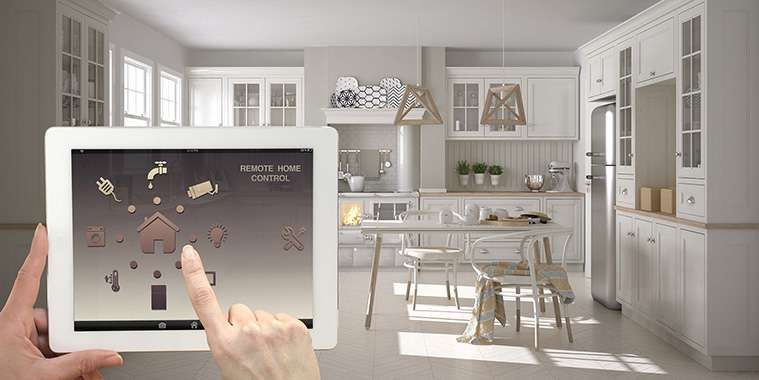With the exponential growth of the Internet of Things (IoT for short), devices, appliances, and environmental systems around our homes have become WiFi and internet enabled. This has resulted in something known as smart home technology, giving you control over nearly everything electrical in your home from a single device (usually a mobile phone or tablet), no matter where you are inside or out.
Understandably, this is a complex and confusing new world. But with a simple start, it’s easy to embrace. Let’s investigate the basics of setting up a smart home.
What is a smart home?
Smart homes combine all the devices (including appliances) that can be remotely automated and controlled through an internet connection via a home wireless (WiFi) network. Smart home devices include anything from home security systems and kitchen appliances, right down to something as simple as a lightbulb or an electrical outlet.
You can control your smart home system through an app installed on your computer, tablet, or mobile phone, which allows you to connect and control your smart devices. With hands-on monitoring, control, and automation you’ll never need to worry about forgetting to run the dishwasher or turn lights off.
Beyond the convenience factor of having everything at your fingertips, other benefits of smart home automation include:
• Increased comfort: Better control and automation of lighting and thermostat means your home is the perfect temperature every time you arrive home or get up in the morning.
• Better energy efficiency: Precise control over unused appliances and devices means less energy consumption.
• Increased security: With home security and camera integration, you never need to be concerned about your belongings when you’re not at home.
• Added safety: If you accidentally leave something on the stove or the oven on, no worries, you can turn them off remotely!
• Better understanding: Smart home systems can provide some amazing insights into your habits and device use around your home.
Where should I start?
The most important thing to consider when planning for your smart home is a smart system app or hub. While most systems apps don’t require a physical hub to give you control over your devices, a smart hub certainly makes control easier through voice commands. Some popular smart system apps and hubs are Amazon Alexa, Google Assistant, Samsung SmartThings and Wink Hub.
If your interest lies mainly with home security and environmental control, you can turn to a home security or monitoring company, or even in some cases your cellular or internet provider. Bell, Telus, Rogers, and ecobee all offer home monitoring, with some even having additional automation features.
Note: The services listed above require a monthly plan, and they may charge you a fee to add additional devices and appliances.
Smart devices to get started with
The next step is to decide on some smart devices to connect through your smart system so you can hit the ground running. The main difference you’ll discover when installing smart devices is the additional steps needed to connect them through your WiFi network. It may seem complex at first, but manufacturers always include easy-to-follow instructions on setup, and if you encounter any issues, they usually have excellent customer support to help you along.
It’s always helpful when looking for these types of products to check customer feedback and reviews on multiple retailers’ websites. You’ll also want to double check to make sure they’re compatible with your smart system app to avoid the headache of having to use more than one app to manage your home.
• Smart home hub You’ll still be able to control everything using your smart system app, but this option’s voice command features mean you don’t always need your mobile device handy to control your home. Some hub options like Amazon Echo and Google Nest also double as speakers, conveniently keeping your favourite music on-demand.
Price range: ~$50 to $400
• Smart thermostat This is more than just a programmable replacement for your basic thermostat. Forget to turn the heat down when you leave for the day? No problem! You can control and automate your home’s heating and cooling from anywhere. Some smart systems can even track your habits and automatically adjust temperatures accordingly.
Price range: ~$40 to $300
• Smart light bulbs These intuitive LED options are not only more energy efficient than their incandescent relatives, you can now have full control over their intensity, timing, and even colour. Just replace your existing bulbs, connect to your smart system, and let your fingers do the rest.
Price range: ~$5 to $60
• Smart switches The modern solution to classic switches and dimmers, you won’t need to replace bulbs to have full remote control over your room lights. Just imagine never having to get up from dinner or your cozy bed to adjust the lights!
Price range: ~$20 to $80
• Smart plugs Yes, even an outlet or power bar can be smart! These gadgets turn simple things like lamps, fans, or basic coffee makers, into remotely programmable and automated devices.
Price range: ~$11 to $40
• Smart cameras If you use a regular CCTV (closed circuit television) camera system, you know how frustrating it can be to sift through hours of footage. Smart cameras’ intuitive motion sensor technology allows them to record only when motion is detected. They can also notify you of any motion detected and you can even view the video feed in real-time using a mobile device or computer. Now if you’re on vacation and someone attempts to gain entry to your home, you can immediately contact authorities.
Price range: ~$50 to $500+
• Smart door locks/deadbolts With a smart lock, you’ll never have to worry about fumbling for your keys with an armload of groceries. The mobile phone in your pocket will unlock it as you approach the door. Some locks are also code-enabled, while others can still use a traditional key in the event you forget your phone. You can also text one-time entry codes to family, neighbours, or even service providers if urgent entry is needed.
Price range: ~$85 to $350
• Smart range/stove/oven Replacing your existing stove with a smart stove is a culinary game changer. You can pre-heat, adjust, and shut it off remotely. A smart oven’s intuitive cooking technology can even make automatic adjustments based on what you’re cooking so you end up with the perfect dish, every time.
Price range: ~$850 to $10,000+
Once you become home smart and feel more comfortable with your smart devices, which can be purchased at most big-box retailers, you should definitely check out what’s possible with these other smart appliances.
Of course this is quite the learning curve and upgrading technology in your home is a substantial adjustment, but the benefits of convenience, energy savings, and overall comfort and security make the jump worthwhile. Good luck!
— Realtor.ca



